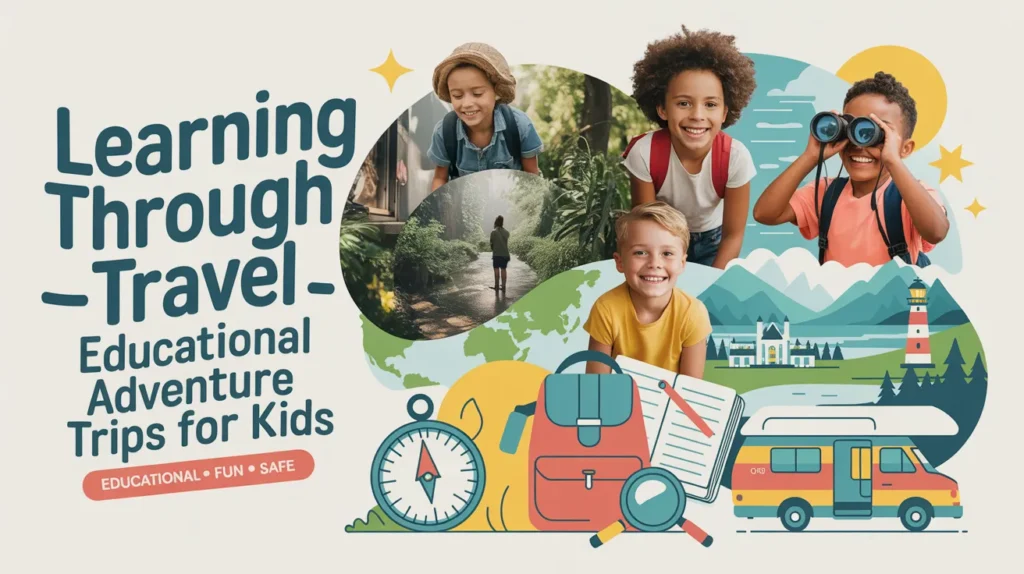
Travel is one of the richest classrooms available. Educational adventure trips turn curiosity into learning by blending real-world experiences with structured reflection. This guide shows parents, teachers, and youth leaders how to design memorable, curriculum-linked trips that develop knowledge, skills, and confidence in children of all ages.
Why Educational Travel Works
- Active learning: Kids learn faster when they touch, see, and do.
- Cross-disciplinary lessons: A single site visit can teach science, history, language, math, and social skills.
- Contextual memory: Experiences anchored to place stick better than facts learned in isolation.
- Social & emotional growth: Independence, teamwork, and problem-solving are practiced naturally.
- Cultural empathy: Meeting different people and places builds perspective and tolerance.
Goals & Learning Outcomes
Set clear objectives before you go. Examples:
- Knowledge: Identify three local plant/animal species or explain a historical event’s causes.
- Skills: Map-reading, observing scientifically, journaling, basic budgeting.
- Attitudes: Curiosity, resilience, environmental stewardship, cultural respect.
Choosing the Right Destination
Match destination to learning goals, age, and logistics.
- Nature-based trips: National parks, farms, coastal habitats — great for biology, ecology, and outdoor skills.
- Cultural trips: Museums, historical towns, artisan workshops — excellent for history, language, and arts.
- STEM trips: Science centers, planetariums, engineering museums, maker spaces — build technical curiosity.
- Service-learning trips: Community projects, conservation activities — teach civic responsibility and teamwork.
- City-based explorations: Public transport, markets, architecture trails — urban literacy and social studies.
Age-Appropriate Activity Ideas
- Ages 4–7: Short walks, scavenger hunts, sensory stations, picture journaling.
- Ages 8–11: Guided experiments, simple citizen-science tasks, map-reading challenges, role-play historical events.
- Ages 12–16+: Project-based fieldwork (sample research), interviews with local experts, budgeting & planning mini-expeditions, reflective presentations.
Sample 3-Day Educational Adventure Itinerary
| Day | Focus | Morning Activity | Afternoon Activity | Learning Task |
|---|---|---|---|---|
| 1 | Local ecology | Guided nature walk & species ID | Pond dip + microscope observations | Create a species field card (group) |
| 2 | History & culture | Visit local historical site & guided tour | Hands-on craft with local artisan | Timeline & artifact sketching |
| 3 | STEM & reflection | Science center workshop | Community cleanup or citizen science | Group presentation + travel journal |
Pre-Trip Planning Checklist
- Define learning objectives and link to curriculum standards where relevant.
- Scout the site (virtually or in person) and confirm suitability for age group.
- Arrange permissions, insurance, and medical forms.
- Choose experienced guides or educators when possible.
- Prepare pre-trip lessons: vocabulary, maps, safety rules, and basic context.
- Build a flexible schedule with learning, free exploration, and rest times.
On-Trip Teaching Strategies
- Ask open questions: “What do you notice? Why might that be?” invites thinking.
- Use stations: Rotate small groups through focused activities for engagement.
- Make it investigative: Give kids a clear mission (e.g., “find three examples of sustainable practice”).
- Balance structure + play: Allow free discovery time to spark curiosity.
- Use simple assessment: Quick exit cards, oral quizzes, or photo evidence of tasks completed.
Safety, Supervision & Child Welfare
- Maintain appropriate adult-to-child ratios (varies by age and activity).
- Share emergency contact info and a daily check-in plan with caregivers.
- Carry a well-stocked first-aid kit and any individual medications.
- Pre-brief children on boundaries, respectful behavior, and environmental rules.
- Check accessibility and dietary needs in advance.
- Vet vendors and guides—ensure they have child-friendly experience and safety procedures.
Budgeting & Funding Ideas
- Create a per-child cost breakdown (transport, entry fees, guides, meals).
- Fundraising options: bake sales, sponsorships, school PTA support, community grants.
- Low-cost alternatives: walking tours, local community partners, volunteer-led activities.
Packing Checklist for Kids (compact)
- Comfortable shoes, weather-appropriate clothing, hat.
- Small backpack with water bottle and snacks.
- Travel journal, pencil, clipboard, hand lens (optional).
- Sun protection, insect repellent, personal medications.
- Reusable bag for trash/collections if allowed (respect site rules).
- Emergency contact card.
Measuring Learning & Impact
- Before–after reflections: Quick pre-trip quiz and post-trip reflections to show growth.
- Portfolios: Collect photos, field notes, sketches, and artifacts (where allowed).
- Presentations: Kids present findings to classmates or parents—builds communication skills.
- Rubrics: Simple rubrics to evaluate specific skills (observation, teamwork, inquiry).
Practical Tips for Smooth Runs
- Keep groups small and use buddy systems.
- Schedule frequent breaks—young kids need downtime.
- Build contingency plans for weather or closures.
- Prepare sensory-friendly options for children who need them.
- Use technology sparingly—encourage observation over screens, but use cameras for documentation.
Sample Activity: “Local Scientist” Mini-Project
- Divide students into teams; assign a habitat or topic.
- Give simple tools (notebook, magnifier, phone camera).
- Teams make three observations, take two photos, and ask one question they want to investigate.
- Back at base, teams share findings and plan one small experiment or investigation to continue learning.
Post-Trip Follow-up: Deepen the Learning
- Turn notes into a class book or blog post.
- Connect with local experts for follow-up Q&A sessions.
- Set long-term projects inspired by the trip (e.g., school garden, recycling pledge).
- Send summary notes and a highlight reel to parents to reinforce learning at home.
Why Reflection Matters
Reflection helps kids turn experience into understanding. Encourage:
- Drawing or writing a favorite moment and why it mattered.
- Group discussions about surprises and unanswered questions.
- A “next steps” list: what they want to learn more about and how.
Conclusion
Educational adventure trips transform passive lessons into lived learning. With clear goals, age-appropriate activities, careful planning, and strong safety practices, travel becomes a powerful tool for developing knowledge, curiosity, and life skills in children. Start small, iterate, and build a culture of exploration that lasts long after the trip ends.
